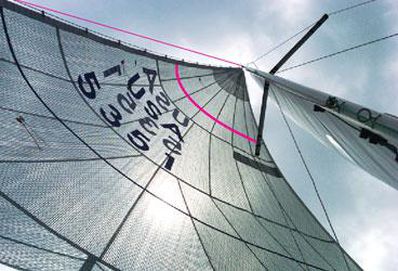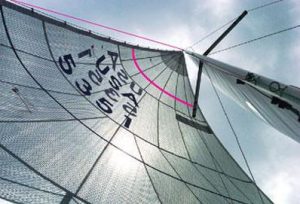

Sail Controls And Their Effects – Sail Controls are the things that you can adjust once afloat to take advantage as the conditions change. I have set these out below in no order of importance. Be aware that some controls on different types of boats will have a varying degree of importance.
Use a practice day to experiment with each control. Initially set up two boats of the same class identically. Then with each boat making a single adjustment, it will very quickly teach you what makes you faster and what doesn’t.
Boom Vang
When sailing upwind, the vang controls the leech of the mainsail. An over tight leech is indicated by stalled leech telltales. By easing the vang until the telltales start to flow indicates the right setting for the wind.
A secondary effect of pulling the vang on is to push the mast forward and with the bend it introduces, flattening the mainsail.
The vang also helps with pointing and in a situation where you need height, the vang is one of the controls that you would employ.
Offwind and on a reach, use the vang to control the leech but remember when reaching that the leech telltales should never be stalled.
The Outhaul
The outhaul is used to power and de-power the mainsail. In light air, pull it on to flatten the bottom part of the mainsail. As the wind increases into the medium range, ease the outhaul to put more power into the sail.
As the breeze increase above the medium range, pull on the outhaul to flatten the bottom of the sail and depower.
The Cunningham – Sail Controls And Their Effects
This control affects the draft position in the sail and pulling it on moves the draft forward and loosens the leech. Pulling on the Cunningham, bends the mast and opens the top of the sail to assist with depowering.
In light air there should be no Cunningham tension. As the wind increases and you start to get overpowered, pull it on to flatten the head of the sail and free the upper leech.
Traveller
The traveller or bridle is used to position the boom in relation to the centreline of the boat.
If you are sailing a boat with a jib, and you are underpowered, the traveller will need to be above the centreline so the boom will be in the middle or thereabouts. As the breeze increases, the traveller will be lowered and the sheet tension increased.
In heavy air, the traveller can be lowered further and the vang and sheet worked harder to keep the boat balanced.
In the case of a single sailed boat the boom will be over the side deck for power. To get the leech tension you need, use a combination of traveller, vang and mainsheet.
Mainsheet
The mainsheet controls the sails angle of attack and also powers up the leech.
Jib Halyard – Sail Controls And Their Effects
The effect of pulling on the jib halyard is to give less sag which gives the jib a flatter entry which is good for heavier wind. In light air ease the halyard to give more luff round and a fuller entry and thus more power.
Jib Cunningham
Similar to the mainsail in that pulling on the jib Cunningham moves the draft of the sail forward. Easing moves the draft progressively aft as the wind decreases.
Jib sheet angle
The changes in angle of the sheet to the clew changes the shape of the jib.
With the sheet more horizontal, or lead back, the foot is tighter and the leech freer. Having the lead back is a great set up for light air or heavy air and gives a freer leech.
If the sheet lead is in the middle position, this gives a fuller more powerful sail and suitable for medium winds.
With the sheet lead way forward, this gives a tighter leech which is good for pointing. When the sheet is forward it works well for lighter air and flat water.
The luff telltales will break evenly if you have the setting right.
Inboard – Outboard Sheet Lead Angles
This position controls the slot between the Main and Jib which affects pointing.
To get an indication of the correct slot, move the lead inboard until the mainsail is almost backwinding. It is important to make sure that the main is not too full or flat for the conditions when setting the angle.
The closer you can sheet means that you can point higher
Jib Sheet Tension – Sail Controls And Their Effects
The leech telltale is the best indicator of whether the tension on the sheet is correct for the conditions.
In light air it should be streaming most of the time and the same goes for heavy air. In medium wind, the leech telltale should be breaking about 50% of the time.
If the telltale is streaming all the time, the leech is too open.

